Chainsaw Carvings Demonstration
Feature Artist: Bob Eigenrauch, Master Chainsaw Carver
Introduction Page | Chainsaw Carving Demo
Figure Carving | Wildlife Carving | Fish Carving
| Totem Carving | Bird Carving | Sign Carving
Horse Carving | Mailbox Carving | Chainsaw Patterns
"Bob Eigenrauch, Master Chainsaw Carver Wolf Demo"
Artisans of the Valley features a variety of chainsaw carvings by Bob Eigenrauch in our online portfolio. The majority of these carvings are completed by Bob, but a few are combined efforts featuring the skills of multiple craftsmen.
This timberwolf carving is a project employing Bob for the rough carving, taking a blank and reaching the shape and profile of the sculpture down to the muscle tone and body definition. This is then followed by Stan Saperstein who completed the detailed carvings.
September 13, 2007 - Press Release
"The Spirit of Timberlane" - Feature Printable PDF Article
 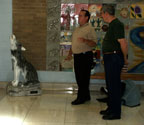 
       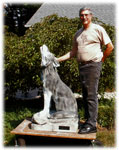
This photo chronology shows the steps from a solid block of poplar (a blank) to a completed life size wolf carving. Blanks can be logs or milled lumber. If the carving is to be placed indoors milled lumber is required. For carvings destined for an outdoor life, logs are the preferable medium.
The carving process starts by tracing a template profile onto the blank. Then beings the rough-in - removing large chunks of outer material that will not be required for the finished figure.
 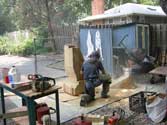 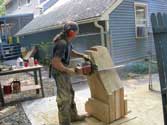 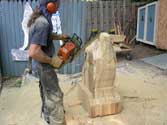 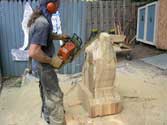 
As the rough-in transitions into more detail the actual features of the carving start to take shape. The body begins to flow into the physical form of a wolf, the head takes shape, the neck, the ears start to protrude. Chainsaws change with specific steps in the process, larger more powerful saws are used for the roughing phases, switching to a midsize saws take care of the next steps.
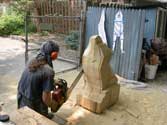 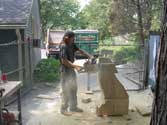    
When the outer form is shaped - the next step is to begin removing material to create voids required to split the blank into sections showing the legs, tail, and other features of the newly forming creature. Muscle tone and rough fur layers, separation of the head and definition of the neck take place using a detail or specialty carving chainsaw.
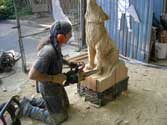  
This wolf carving is a combination effort - a carving started by Bob and finished by Stan. The body is smoothed and the muscle tone for this project were shaped using a carbide power carver. This high speed wood grinders remove material while starting the smoothing and finishing process.
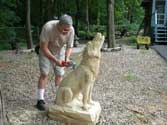  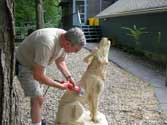  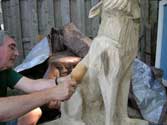 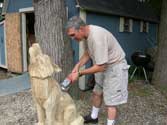 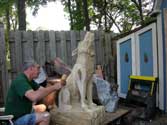
Switching from power to hand work - Stanley's larger scale wood sculpture and carving tools come out to begin the detail work. The carving was then coated in a plaster (gesso) to seal all the cracks and prep the piece for painting.
Painting takes place using various spray techniques, brushes, and other hand techniques to create texture and layering of colors. Oils, acrylics, and enamels can all be employed for color before a clear coat is applied in the appropriate sheen.
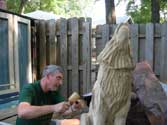   
|


